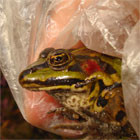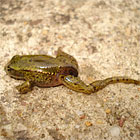Ranavirus surveillance project in the Netherlands, 2011
 Ranavirus spp. infection was responsible for a mass die-off of various species of water frogs (Pelophylax spp.) and smooth newts (Lissotriton vulgaris) in September 2010 in the Dwingelderveld National Park in the Netherlands. This was the first case of ranavirus in the Netherlands. Ranaviruses are highly infectious viruses, readily transmitted by human activity and pose a serious threat to amphibian, reptile and fish populations.
Ranavirus spp. infection was responsible for a mass die-off of various species of water frogs (Pelophylax spp.) and smooth newts (Lissotriton vulgaris) in September 2010 in the Dwingelderveld National Park in the Netherlands. This was the first case of ranavirus in the Netherlands. Ranaviruses are highly infectious viruses, readily transmitted by human activity and pose a serious threat to amphibian, reptile and fish populations.
 It is currently unknown as to how ranavirus entered the Netherlands; the impact it is likely to have on susceptible species will depend on the distribution of this and other forms of ranaviruses amongst cold-blooded vertebrates in the Netherlands.
It is currently unknown as to how ranavirus entered the Netherlands; the impact it is likely to have on susceptible species will depend on the distribution of this and other forms of ranaviruses amongst cold-blooded vertebrates in the Netherlands.
This project aims to increase our knowledge about the prevalence of Ranavirus spp. infections in amphibians in the Netherlands. Post-mortem investigation will be performed on amphibian cadavers submitted to the DWHC in 2011. At the same time the DWHC will monitor the ranavirus situation on the Dwingelderveld National Park. These results will be used to create guidance as to the control and prevention of ranavirus in the Netherlands. The research will be carried out by the DWHC and RAVON (the Dutch organisation for amphibian, reptile and fish research) in conjunction with Dwingelderveld Natuurmonumenten.
How can you help?
In order to help this project please report if you notice a large number of dead amphibians via the submission form on our website or by calling the DWHC on 030 – 253 79 25. After submitting your form you will be contacted by the DWHC who will advise you on how to package the cadaver(s) and arrange collection of the package from your home or place of work.



